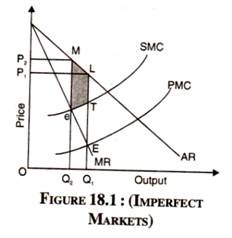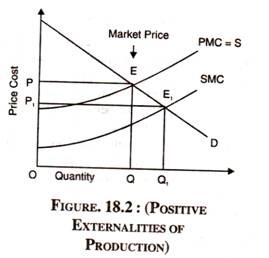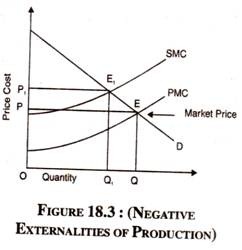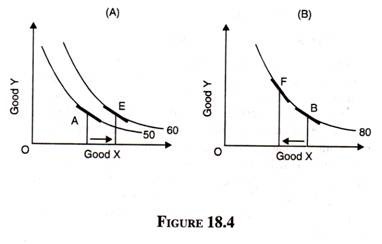MARKET FAILURE:
An economic term that encompasses a situation where, in any given market, the quantity of a product demanded by consumers does not equate to the quantity supplied by suppliers. This is a direct result of a lack of certain economically ideal factors, which prevents equilibrium.
8 Major Causes of Market Failure (Explained With Diagram)
Some of the major causes of market failure are: 1. Incomplete markets, 2. Indivisibilities, 3. Common Property Resources, 4. Imperfect Markets, 5. Asymmetric Information, 6. Externalities, 7. Public Goods and 8. Public Bads.
Meaning:
In the real world, there is non-attainment of Pareto optimality due to a number of constraints in the working of perfect competition. An important cause of environmental degradation is market failure. It means poor functioning of markets for environmental goods and services. It reflects failure of government policy in removing market distortions created by price controls and subsidies.
1. Incomplete markets:
Markets for certain things are incomplete or missing under perfect competition. The absence of markets for such things as public goods and common property resources is a cause of market failure. There is no way to equate their social and private benefits and costs either in the present or in the future because their markets are incomplete or missing.
2. Indivisibilities:
The Paretian optimality is based on the assumption of complete divisibility of products and factors used in consumption and production. In reality, goods and factors are not infinitely divisible. Rather, they are indivisible. The problem of divisibility arises in the production of those goods and services that are used jointly by more than one person.
An important example is of road in a locality. It is used by a number of persons in the locality. But the problem is how to share the costs of repairs and maintenance of the road. In fact, very few persons will be interested in its maintenance. Thus marginal social costs and marginal social benefits will diverge from each other and Pareto optimality will not be achieved.
3. Common Property Resources:
Another cause of market failure is a common property resource. Common ownership when coupled with open access, would also lead to wasteful exploitation in which a user ignores the effects of his action on others. Open access to the commonly owned resources is a crucial ingredient of waste and inefficiency.
Its most common example is fish in a lake. Anyone can catch and eat it but no one has an exclusive property right over it. It means that a common property resource is non-excludable (anyone can use it) and non-rivalrous (no one has an exclusive right over it). The lake is a common property for all fishermen.
When a fisherman catches more fish, he reduces the catch of other fishermen. But he does count this as a cost, yet it is a cost to society. Because the lake is a common property resource where there is no mechanism to restrict entry and to catch fish. The fisherman who catches more fish imposes a negative externality on other fishermen so that the lake is overexploited.
This is called the tragedy of the commons which leads to the elimination of social gains due to the overuse of common property. Thus when property rights are common, indefinite or non-existent, social costs will be more than private costs and there will not be Pareto Optimality.
4. Imperfect Markets:
Pareto efficiency increases under perfect competition. But it declines under market distortions or imperfections. Let us consider a case of monopoly. Initially, monopoly equilibrium is at point E where the private marginal cost curve, PMC, cuts the marginal revenue curve, MR, from below.
The monopolist produces OQ1 output at OP1 price. But the production process generates smoke in the air. Therefore, the pollution board levies a tax equal to ТЕ on the monopoly firm. The imposition of a pollution tax is, in fact, a fixed cost to the monopoly firm. Now the social marginal cost curve cuts the marginal revenue curve at point e.
The monopolist increases the price of his product from OP1 to OP2and restricts output to OQ2 and thereby reduces consumers’ surplus to Q2 MLQ1 (= OQ1 LP1 – OQ2 MP2). In fact, Q2 MLQ1 is the social cost of OQ2 output. But the net loss to society is Q2 MLQ1 – TE= eMLT, the shaded area in the figure.
5. Asymmetric Information:
Pareto optimality assumes that producers and consumers have perfect information regarding market behaviour. But according to Joseph Stiglitz, “In the real world, there is asymmetric (incomplete) information due to ignorance and uncertainty on the part of buyers and sellers. Thus they are unable to equate social and private benefits and costs.”
Suppose a producer introduces a new antipollution device in the market. But it is very difficult for him to predict the current demand of his product. On the other hand, consumers may be ignorant about quality and utility of this anti-pollution device. In some cases, information about market behaviour in the future may be available but that may be insufficient or incomplete. Thus market asymmetries, fail to allocate efficiently.
6. Externalities:
The presence of externalities in consumption and production also lead to market failure. Externalities are market imperfections where the market offers no price for service or disservice. These externalities lead to malallocation of resources and cause consumption or production to fall short of Pareto optimality.
Externalities, lead to the divergence of social costs from private costs, and of social benefits from private benefits. When social and private costs and social and private benefits diverge, perfect competition will not achieve Pareto optimality.
Because under perfect competition private marginal cost (PMC) is equated to private marginal benefit (i.e. the price of the product). We discuss below how external economies and diseconomies of consumption and production affect adversely the allocation of resources and prevent the attainment of Pareto optimality.
Positive Externalities of Production:
According to Pigou, when some firm renders a benefit or cost of a service to other firms without appropriating to itself all the benefits or costs of his service, it is an external economy of production. External economies of production accrue to one or more firms in the form of reduced average costs as a result of the activities of another firm.
In other words, these economies accrue to other firms in the industry with the expansion of a firm. They may be the result of reduced input costs which lead to pecuniary external economies. Whenever external economies exist, social marginal benefit will exceed private marginal benefit and private marginal cost will exceed social marginal cost.
This is illustrated in Figure 18.2 where PMC is the private marginal cost curve or supply curve of firms. The demand curve D intersects the PMC curve at point E and determines the competitive market price OP and output OQ.
SMC is the social marginal cost curve which intersects the demand curve D at point E1 and determines the social optimum output level OQ1 at price OP1. Since for every unit of output between OQ and OQ1 social marginal cost (ОР1) is less than the competitive market price OP, its production involves a net social gain equal to QQ1.
Negative Externalities of Production:
When the production of a commodity or service by a firm affects adversely other firms in the industry, social marginal cost is higher than social marginal benefit. Suppose, a factory situated in a residential area emits smoke which affects adversely health and household articles of the residents.
In this case, the factory benefits at the expense of residents who have to incur extra expenses to keep themselves healthy and their households clean. These are social marginal costs because of harmful externalities which are higher than private marginal cost and also social marginal benefit.
This is illustrated in Fig. 18.3 where the PMC curve which intersects the D curve at point E and determines the competitive price OP and output OQ. But the socially optimum output is OQ1and price is OP1, as determined by the intersection of SMC and D curve at point E1.
Thus the firms are producing Q1 Q more than the social optimal output OQ1. In this case, for every unit between Q1 and Q, social marginal cost (SMC) is more than the competitive market price OP. Thus its production involves a social loss i.e.. OQ – OQ1 – QQ1.
Positive Externalities in Consumption:
Externalities in Consumption lead to non-attainment of Pareto optimality. External economies of consumption arise from non-market interdependences of the satisfactions enjoyed by different consumers. An increase in the consumption of a good or service which affects favourably the consumption patterns and desires of other consumers is an external economy of consumption.
When an individual installs a TV set, the satisfaction of his neighbours increases because they can watch TV programmes free at his place. Here social benefit is larger and social cost is lower than the private benefit and cost. But the TV owner is likely to use his TV set to a smaller extent than the interests of society require because of the inconvenience and nuisance caused by his neighbours to him.
Negative Externalities in Consumption:
Negative externalities in consumption arise when the consumption of a good or service by one consumer leads to reduced utility (dissatisfaction or loss of welfare) of other consumers. Negative externalities in consumption arise in the case of fashions and articles of conspicuous consumption which reduce their utility to some consumers. For example, smokers cause disutility to non-smokers, and noise nuisance from stereo systems to neighbours etc. Such diseconomies of consumption prevent the attainment of Pareto optimality.
Suppose there are two room-mates A and B. Individual A likes to smoke while individual В likes clean air. Further, B’s utility of consuming clean air is affected by individual A’s smoking. This is explained in terms of Figure 18.4 (A) & (B). Initially, individual A’s utility from smoking gives him 50 utilis at point A while individual B’s consumption of clean air gives him 80 utilis at point B. When there are no externalities in consumption, the tangent at point A and point В are parallel to each other.
If individual A smokes at his leisure then his utility increases to 60 utilis and he moves to point E. The effect of individual A’s smoking reduces the utility of clean air to individual В who moves from point В to point F on the same utility curve.
Individual A has moved on a higher utility curve from 50 to utility curve 60, but the non-smoker is on the same utility curve 80. Thus Pareto optimality is not attained because the utility of one consumer (smoker) A has increased whereas the utility level of the other consumer (non-smoker) В has been reduced.
7. Public Goods:
Another cause of market failure is the existence of public goods. A public good is one whose consumption or use by one individual does not reduce the amount available for others. An example of a public good is water which is available to one person and is also available to others without any additional cost. Its consumption is always joint and equal.
It is non-excludable if it can be consumed by anyone. It is non-rivalrous if no one has an exclusive rights over its consumption. Its benefits can be provided to an additional consumer at zero marginal cost. Thus public goods are both non-excludable and non- rivalrous. Moreover, environmental quality is generally considered as a public good and when it is valued at market price, it leads to market failure.
The Paretian condition for a public good is that its marginal social benefit (MSB) should equal its marginal social cost (MSC). But the characteristics of a public good are such that the economy will not reach a point of Pareto optimality in a perfectly competitive market. Public goods create externalities.
The externality starts when the marginal cost of consuming or producing an additional unit of a public good is zero but a price above zero is being charged. This violates the Paretian welfare maximization criterion of equating marginal social cost and marginal social benefit. This is because the benefits of a public good must be provided at a zero marginal social cost.
Suppose potable water is supplied by the municipal corporation. There are two individuals A and В who use it. Both consume the same quantity of water. But they differ in how much they are willing to pay for any given quantity.
This is illustrated in Figure 18.5. where Da and Db are the demand curves of two individuals A and В respectively. Therefore, demand prices are OPa and OPb corresponding to a given quantity OW of water. The curve ΣD is the vertical summation of Da and Dbcurves.
The Lindhal equilibrium for a public good exists where the sum of the individual prices equal marginal cost. Therefore,
OP = OPa + OPb = MCW
But each consumer is being charged a different price. This is a case of price discrimination because price OPa is greater than price OPb for the same quantity of water OW. Hence there is market failure.
8. Public Bads:
There are also public bads in which one person experiencing some disutility does not diminish the disutility of another, such as air and water pollution. Public goods and public bads cannot be handled by the institution of private property. K.E. Boulding has explained public bads with the following example: “If someone drives his car into my living room and pollutes it, I can sue him for damages. This is a private bad. But if someone congests the roads or pollutes the air, however, there is not much I can do about it as an individual. This is public bad.”
Market failure is a necessary but not a sufficient condition for intervention. To be truly worthwhile, a government intervention must outperform the market or improve its functions. Second, the benefits from such intervention must exceed the costs of planning, implementation, and enforcement, as well as any indirect and unintended costs of distortions introduced to other sectors of the economy by such intervention.















No comments:
Post a Comment